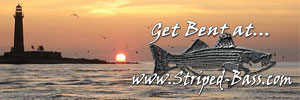|
GrayBeards
Join Date: Jun 2002
Location: weymouth, ma
Posts: 345
|
 Reading the Water
Reading the Water
i saw this on another site and thought it might make a cool addition to this forum
Demystifying The Beach
A few years back, a guy on the WMI surf fishing message board
using the board name, Bassdozer put this up in
response to a question about beach front fishing. It
is, IMHO, chapter and verse of the surf fishermans
hand book, regardless of where you are. If you are on
the beach, fishing, the following is absolutely the
most thorough explanation of sand beach structure I've
ever read. All the information and common sense you
could hope for.
Basically, there are four primary sand structures that
define the character of a beach and that attract fish
to feed on a beach. All fish-attracting sand
structures on the beach can fit into one of the four
following descriptions:
1) POINTS - WHAT IS IT. Points extend out from shore
and can be way big or surprisingly small protursions.
The classic point configuration extends out at right
angle to the beach. Sometimes the beach may take a
turn and it may look more like a "bend", but it still
is a big, rounded point. Sometimes, points are
actually the beginning of bars, and in these cases, I
categorize and fish them as bars (see below), Not as
points.
HOW TO FISH. It is not uncomon to have wadable shoal
water, more white water, and a faster sweep on points.
It is classic for fish to feed at the "tip" of a
point, including right on the tip, or in the open
water to the left or right of the tip. Going back
towards the beach, anywhere along the sloping sides of
a sandy point can hold fish, particularly in the
"pocket" which is a scooped out depression just out
from the base of the point on both sides.
2) BOWLS - WHAT IS IT. Bowls indent into the shore and
typically form between two points. Bowls can be wide
and deep in a classic "tea cup" configuration. At the
other extreme, they can look like hardly much more
than a straight, featureless stretch between points,
but still a bown, as you will see as wind and tide
shape it over time.
HOW TO FISH IT. Fish along both the right and left
rims of a bowl where the base of the points end and
transition into the of bottom of the bowl.
3) BARS - WHAT IS IT. Bars parallel the shore and
typically, the most important bar is the outer bar. If
your are new to surf fishing, then there's two more
words you should know about surf fishing..."Be" and
"careful".
HOW TO FISH. It is not uncommon to have wadable shoals
water, more white water, and a faster sweep along the
entire length of bars. Fish will usually feed along
the outer sloping front side fo the bar, particularly
the bottom where the sloping front of the bar ends and
transitions into the trough. A "cut" is a classic and
highly productive spot between two parallel bars which
often forms a conduit where water from the inner and
outer guts sluices thorough between the bars. A cut
can range from (1) very treacherous "rip" water right
in the gut or (2) it can be more complacent water
which scoops out depressions or "holes" just inside
and just out side of the gut, or (3) a cut can form
both rips and holes.
TROUGHS - WHAT IS IT. Troughs parallel the shore(or
bars) and it sounds like Texans refer to these as
"guts". A trough can exist paralleling the sides of a
bowl even if there is no accompanying paralles bar.
But usually trought, or guts, accompany and parallel
bars.
HOW TO FISH. Fish often prefer to feed along the
sloping sides of a trough, or gut, particularly if the
sides of a trough has a stiff upper "lip" where it
transitions into the adjacent shallower structure (bar
or beach).
THAT'S IT! - Points, Bowls, Bars, and Troughs (Guts)
are the only four primary structures on a beach. Other
sand structures are secondary and cannot exist without
the prescence of a point, bowl, bar or gut. These
secondary sand structures include tips, pockets, cuts,
rips, and holes.
COOL PATTERNS FORM! - The coolest thing is to
consciously make note of the primary/secondary
structures you hitfish on. Why? Because you can then
usually move down the beach and continue to hit fish
in the exact identical types of structures for many
miles. That is, if you bang fish on the left hand side
of a point, the fish will pretty much be on the left
hand side of all points down the beach. That is, if
you take fish in the center of a bowl, or in the
pocket of a point, or in a pronounced trough,
paralleling the shore, then you can move along to
other identically structured bowl, pockets, guts, and
expect to catch fish in the same areas. Often, this
becomes a pattern, which may last for one day, a few
days, a week or even form an extended pattern for an
entire season. You should know what the fish are doing
and focus your efforts on being in the same spots that
the fish are in.
READING THE BEACH MADE EASY - A lot of times people
make a big issue about "reading the beach". But ir is
easy if you just focus on finding these four promary
structures, and then target the secondary "spots on
the spots". You can dissect the layout of any sand
beach into these defined structrures. Then you can
methodically fish them, thereby identifying which
structure the fish are not currently using. If you do
so, you put yourself in the company of gamefish who
also focus on these four primary structures and
especially the secondary ones.
|


